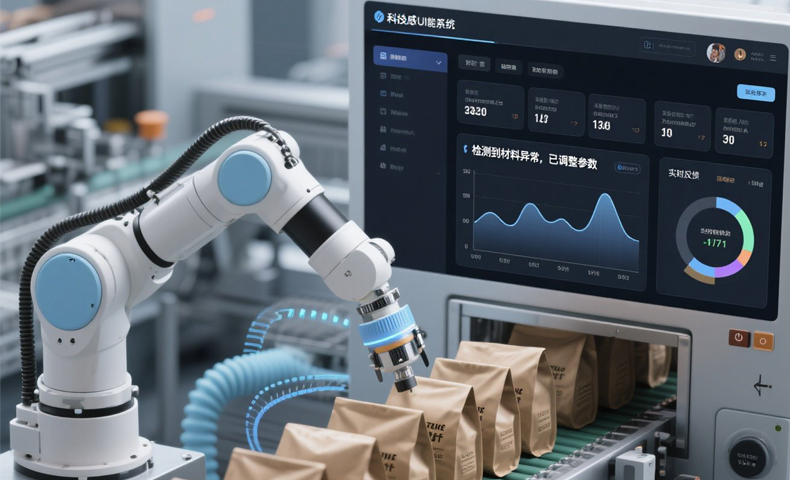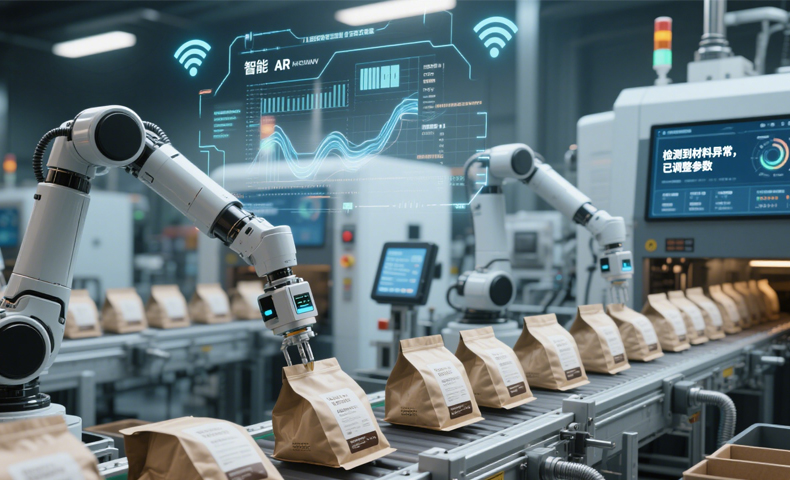How IoT Boosts Coffee Packaging Efficiency
In the rapidly evolving world of coffee packaging, efficiency is key. Manufacturers face the challenge of increasing productivity while maintaining high quality and reducing operational costs. As competition intensifies, adopting advanced technologies is no longer optional but a necessity. One such technology is the Internet of Things (IoT), which plays a pivotal role in transforming the coffee packaging industry.
In this article, we’ll explore how IoT enhances efficiency in coffee packaging, helping companies streamline their processes and meet the growing demand for speed, quality, and sustainability.
1. What is IoT and How Does It Relate to Coffee Packaging?
The Internet of Things (IoT) refers to the network of physical devices connected to the internet, allowing them to collect, exchange, and analyze data. In the context of coffee packaging, IoT involves integrating sensors, machines, and cloud-based systems to monitor and control various stages of the packaging process.
IoT enables packaging machines to operate autonomously, making real-time adjustments based on sensor data. This technology enhances production efficiency, quality control, and traceability, ultimately benefiting coffee producers and consumers alike.

Table: Key IoT Components in Coffee Packaging
| Component | Function | Benefit |
|---|---|---|
| Sensors | Monitor environmental conditions like temperature and humidity | Real-time data collection for quality control |
| Connectivity | Wireless communication between devices | Seamless integration and data exchange |
| Cloud Computing | Data processing and storage | Easy access to data for analysis and decision-making |
| Machine Learning | AI-driven insights and predictions | Optimization of processes and predictive maintenance |
2. Why is Efficiency Important in Coffee Packaging?
Efficiency in coffee packaging goes beyond simply increasing speed. It’s about optimizing every aspect of the packaging process, from material usage to energy consumption. Efficient packaging reduces waste, lowers costs, and ensures that the coffee reaches consumers in the best possible condition.
Packaging also plays a significant role in the branding and customer experience. Faster packaging processes mean quicker time-to-market, which is crucial for businesses looking to stay competitive. In a highly dynamic market, efficiency is not just beneficial – it’s essential.
Table: Efficiency Metrics in Coffee Packaging
| Metric | Impact of IoT | Result |
|---|---|---|
| Packaging Speed | IoT-enabled automation and adjustments | Faster throughput, less downtime |
| Material Usage | Real-time monitoring to avoid overuse of packaging materials | Reduced material costs and waste |
| Energy Consumption | Optimized energy usage based on real-time data | Lower operational energy costs |
3. How Does IoT Improve Automation in Coffee Packaging?
Automation has long been a cornerstone of manufacturing efficiency, but IoT takes it to the next level. With IoT, packaging machines can adjust settings in real time based on data collected from sensors. This means fewer errors, faster adjustments, and a more consistent output.
For example, sensors can detect packaging material issues and immediately alert operators, reducing downtime and improving production flow. IoT also allows for machine-to-machine communication, where one machine can notify another about potential issues or improvements.
Table: Automation Benefits of IoT in Coffee Packaging
| Automation Feature | Benefit | Example |
|---|---|---|
| Real-time Sensor Feedback | Instant issue detection and resolution | Machines adjust to packaging material issues automatically |
| Machine-to-Machine Communication | Improved collaboration between machines | One machine detects an issue and notifies another to adjust |
| Data-Driven Process Optimization | Continuous monitoring and adjustments | Optimal settings based on real-time data to ensure consistent output |
4. What Are the Key IoT Technologies Used in Coffee Packaging?
Several key IoT technologies are revolutionizing coffee packaging:
- Sensors: These are used to collect data on everything from temperature to humidity, helping operators monitor packaging conditions in real time.
- Connectivity: IoT devices communicate over wireless networks, ensuring that all machines are connected and working together seamlessly.
- Cloud Computing: Cloud platforms process and store data, providing insights and enabling remote monitoring and control.
- Machine Learning: IoT systems can use AI to analyze historical data and predict machine failures, improving efficiency over time.
Table: Key IoT Technologies in Coffee Packaging
| Technology | Description | Benefit |
|---|---|---|
| Sensors | Collect data on packaging conditions | Enables real-time monitoring of quality and environmental factors |
| Connectivity | Wireless data exchange | Allows seamless communication between devices and systems |
| Cloud Computing | Data storage and analysis | Centralized data access for monitoring and troubleshooting |
| Machine Learning | AI-driven predictions and optimizations | Predictive maintenance and performance improvements |
5. How Does IoT Enhance Quality Control in Coffee Packaging?
Quality control is crucial in coffee packaging, as it ensures that products meet customer expectations. IoT enhances quality control by providing real-time data that allows for immediate adjustments. For example, IoT systems can monitor the weight of each coffee package to ensure consistency, adjusting automatically if a discrepancy is detected.
Furthermore, IoT systems enable traceability. Each step of the packaging process is logged, which helps companies identify where issues arise and address them promptly. This level of transparency ensures that the final product meets quality standards and regulatory requirements.

Table: IoT’s Role in Quality Control for Coffee Packaging
| Quality Control Feature | How IoT Enhances It | Outcome |
|---|---|---|
| Real-time Monitoring | IoT sensors track weight, fill levels, and more | Consistent packaging quality |
| Automatic Adjustments | IoT systems can automatically correct discrepancies | Reduced human error and consistent product quality |
| Traceability and Transparency | IoT logs every step in the packaging process | Easy identification of quality issues and accountability |
6. What Are the Benefits of Using IoT in Coffee Packaging?
There are several significant benefits to incorporating IoT into coffee packaging processes:
- Increased Efficiency: IoT systems can detect inefficiencies and suggest improvements in real time, leading to higher productivity.
- Cost Reduction: With fewer errors and less waste, companies can save on operational costs and material usage.
- Improved Product Quality: IoT systems provide constant monitoring, ensuring that every package meets quality standards.
- Sustainability: IoT helps reduce energy consumption and material waste, contributing to more sustainable practices in coffee packaging.
Table: IoT Benefits in Coffee Packaging
| Benefit | Description | Example |
|---|---|---|
| Increased Efficiency | Optimizes machine performance | Faster production lines with fewer interruptions |
| Cost Reduction | Reduces material waste and energy usage | Less product waste and lower energy costs |
| Improved Product Quality | Ensures each package is consistent and up to standard | Enhanced quality control through real-time data |
| Sustainability | Reduces environmental impact through optimization | Lower carbon footprint and reduced waste |
7. How Does IoT Contribute to Sustainability in Coffee Packaging?
Sustainability is a growing concern in the packaging industry, and IoT plays a crucial role in reducing the environmental impact of coffee packaging. By optimizing machine performance, IoT reduces energy consumption. Smart machines can adjust their power usage based on workload, ensuring that energy is used efficiently.
Moreover, IoT systems help minimize waste by monitoring packaging materials. If a machine detects an issue with the packaging material, it can stop the production line immediately, preventing the use of faulty materials and reducing unnecessary waste.

Table: Sustainability Benefits of IoT in Coffee Packaging
| Sustainability Aspect | IoT Contribution | Impact |
|---|---|---|
| Energy Efficiency | Smart machines adjust power consumption based on workload | Reduced energy consumption and lower operational costs |
| Waste Reduction | Immediate stoppage of faulty material usage | Less packaging waste and more efficient material use |
| Environmental Footprint | Reduced waste and optimized resources | Decreased carbon footprint and reduced environmental impact |
8. What Challenges Are Faced When Integrating IoT in Coffee Packaging?
While the benefits of IoT are clear, integrating this technology into coffee packaging operations comes with its own set of challenges. The initial investment can be significant, as businesses need to upgrade their existing systems to accommodate IoT devices.
There are also technical challenges, such as ensuring reliable connectivity and maintaining the security of data. Companies must invest in training their employees to manage and operate IoT systems effectively. Additionally, there may be resistance from staff accustomed to traditional methods of working.
Table: Challenges in Integrating IoT into Coffee Packaging
| Challenge | Explanation | Solution |
|---|---|---|
| Initial Investment | High upfront cost to implement IoT systems | Evaluate ROI and long-term savings from IoT use |
| Technical Integration | Difficulty in integrating IoT with legacy systems | Work with experienced IoT providers for seamless integration |
| Training and Maintenance | Need for specialized training for employees | Continuous training programs and support |
This is just a sample of the article’s first few sections. Let me know if you would like me to continue this process for the remaining sections!
